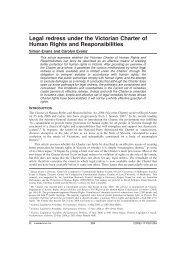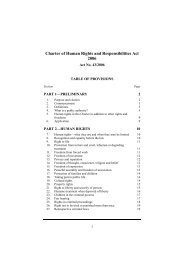The Impact of the Corporate Form on Corporate Liability for ...
The Impact of the Corporate Form on Corporate Liability for ...
The Impact of the Corporate Form on Corporate Liability for ...
Create successful ePaper yourself
Turn your PDF publications into a flip-book with our unique Google optimized e-Paper software.
9. Piercing <str<strong>on</strong>g>the</str<strong>on</strong>g> corporate veil using <str<strong>on</strong>g>the</str<strong>on</strong>g> comm<strong>on</strong> law<br />
9.1 No settled principle <strong>on</strong> piercing<br />
107. Under comm<strong>on</strong> law, <str<strong>on</strong>g>the</str<strong>on</strong>g>re is no clear doctrine or established principle by which courts will<br />
pierce <str<strong>on</strong>g>the</str<strong>on</strong>g> corporate veil to acknowledge <str<strong>on</strong>g>the</str<strong>on</strong>g> role <str<strong>on</strong>g>of</str<strong>on</strong>g> o<str<strong>on</strong>g>the</str<strong>on</strong>g>r companies in a corporate group<br />
or <str<strong>on</strong>g>the</str<strong>on</strong>g> liability <str<strong>on</strong>g>of</str<strong>on</strong>g> members <strong>for</strong> corporate obligati<strong>on</strong>s. As Rogers AJA stated in Briggs<br />
v James Hardie (1989) 16 NSWLR 549 (at 567):<br />
<str<strong>on</strong>g>The</str<strong>on</strong>g> threshold problem arises from <str<strong>on</strong>g>the</str<strong>on</strong>g> fact <str<strong>on</strong>g>the</str<strong>on</strong>g>re is no comm<strong>on</strong>, unifying principle, which<br />
underlies <str<strong>on</strong>g>the</str<strong>on</strong>g> occasi<strong>on</strong>al decisi<strong>on</strong> <str<strong>on</strong>g>of</str<strong>on</strong>g> courts to pierce <str<strong>on</strong>g>the</str<strong>on</strong>g> corporate veil. Although ad hoc<br />
explanati<strong>on</strong> may be <str<strong>on</strong>g>of</str<strong>on</strong>g>fered by a court which so decides, <str<strong>on</strong>g>the</str<strong>on</strong>g>re is no principled approach to<br />
be derived from <str<strong>on</strong>g>the</str<strong>on</strong>g> authorities…<br />
108. Despite comments made decades ago by judges such as Windeyer J that a trend is<br />
emerging whereby courts are able to look behind <str<strong>on</strong>g>the</str<strong>on</strong>g> legal pers<strong>on</strong>ality to examine <str<strong>on</strong>g>the</str<strong>on</strong>g><br />
purpose <str<strong>on</strong>g>of</str<strong>on</strong>g> its creati<strong>on</strong> and c<strong>on</strong>trol, <str<strong>on</strong>g>the</str<strong>on</strong>g>re remains no settled jurisprudence <strong>on</strong> <str<strong>on</strong>g>the</str<strong>on</strong>g><br />
circumstances that require such an examinati<strong>on</strong>. 85<br />
109. And despite <str<strong>on</strong>g>the</str<strong>on</strong>g> comments <str<strong>on</strong>g>of</str<strong>on</strong>g> Rogers AJA – also made over a decade ago – that <str<strong>on</strong>g>the</str<strong>on</strong>g>re is<br />
merit in <str<strong>on</strong>g>the</str<strong>on</strong>g> argument that <str<strong>on</strong>g>the</str<strong>on</strong>g> assets and liabilities <str<strong>on</strong>g>of</str<strong>on</strong>g> a parent and subsidiary should be<br />
aggregated where it can be shown that <str<strong>on</strong>g>the</str<strong>on</strong>g> attitude <str<strong>on</strong>g>of</str<strong>on</strong>g> <str<strong>on</strong>g>the</str<strong>on</strong>g> company in commercial life was<br />
to treat <str<strong>on</strong>g>the</str<strong>on</strong>g> assets and liabilities as those <str<strong>on</strong>g>of</str<strong>on</strong>g> <str<strong>on</strong>g>the</str<strong>on</strong>g> group, <str<strong>on</strong>g>the</str<strong>on</strong>g>re is no settled doctrine in law in<br />
those terms. 86<br />
110. However, in James Hardie Rogers AJA states two propositi<strong>on</strong>s that can be safely<br />
accepted. First, that potential <strong>on</strong>ly to exercise c<strong>on</strong>trol over <str<strong>on</strong>g>the</str<strong>on</strong>g> subsidiary is insufficient to<br />
pierce <str<strong>on</strong>g>the</str<strong>on</strong>g> corporate veil; and sec<strong>on</strong>d, <str<strong>on</strong>g>the</str<strong>on</strong>g> fact <str<strong>on</strong>g>of</str<strong>on</strong>g> some c<strong>on</strong>trol over <str<strong>on</strong>g>the</str<strong>on</strong>g> subsidiary is<br />
insufficient (at 575). Bey<strong>on</strong>d that, he says, lies uncertainty.<br />
111. In <str<strong>on</strong>g>the</str<strong>on</strong>g> absence <str<strong>on</strong>g>of</str<strong>on</strong>g> a settled doctrine, it is necessary to look at <str<strong>on</strong>g>the</str<strong>on</strong>g> case law in which <str<strong>on</strong>g>the</str<strong>on</strong>g><br />
noti<strong>on</strong> <str<strong>on</strong>g>of</str<strong>on</strong>g> piercing <str<strong>on</strong>g>the</str<strong>on</strong>g> corporate veil has been c<strong>on</strong>sidered. <str<strong>on</strong>g>The</str<strong>on</strong>g> following looks at some <str<strong>on</strong>g>of</str<strong>on</strong>g><br />
<str<strong>on</strong>g>the</str<strong>on</strong>g> authorities, and seeks to assess those circumstances in which courts may lift <str<strong>on</strong>g>the</str<strong>on</strong>g><br />
corporate veil. <str<strong>on</strong>g>The</str<strong>on</strong>g>se categories are discussed below. It should be noted that <str<strong>on</strong>g>the</str<strong>on</strong>g>se<br />
categories are not rigidly defined. 87 We will discuss relevant Australian case law, as well<br />
as UK law, which is in some regards fur<str<strong>on</strong>g>the</str<strong>on</strong>g>r advanced than <str<strong>on</strong>g>the</str<strong>on</strong>g> Australian jurisprudence. 88<br />
112. We have endeavoured to focus <strong>on</strong> that case law that establishes basic principles <str<strong>on</strong>g>of</str<strong>on</strong>g><br />
piercing and <str<strong>on</strong>g>the</str<strong>on</strong>g>n turn to case law that is most relevant to <str<strong>on</strong>g>the</str<strong>on</strong>g> c<strong>on</strong>text <str<strong>on</strong>g>of</str<strong>on</strong>g> holding corporate<br />
liability <strong>for</strong> involvement in serious internati<strong>on</strong>al crimes or human rights violati<strong>on</strong>s.<br />
84<br />
85<br />
86<br />
87<br />
88<br />
Australian Securities Commissi<strong>on</strong> v AS Nominees Ltd (1995) 62 FCR 504.<br />
Gort<strong>on</strong> v FCT (1965) 113 CLR 604 at 627.<br />
Qintex Australia Finance Ltd v Schroders (1990) ACSR 267 at 269.<br />
Ford's Principles <str<strong>on</strong>g>of</str<strong>on</strong>g> Corporati<strong>on</strong> Law at [4.250].<br />
UK law, although persuasive in Australian law, is not binding <strong>on</strong> Australian courts. <str<strong>on</strong>g>The</str<strong>on</strong>g> UK cases are <str<strong>on</strong>g>of</str<strong>on</strong>g>ten cited<br />
in Australian judgments.<br />
9.2.2007 Page 21



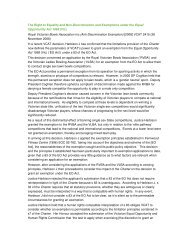
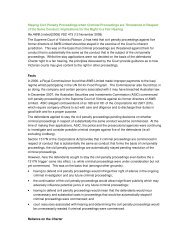
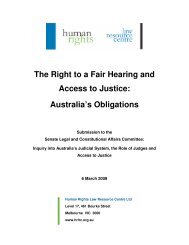
![Maslov v Austria [2008] ECHR - Human Rights Law Centre](https://img.yumpu.com/38882316/1/190x245/maslov-v-austria-2008-echr-human-rights-law-centre.jpg?quality=85)
![Kortel v Mirik [2008].pdf - Human Rights Law Centre](https://img.yumpu.com/38882257/1/190x245/kortel-v-mirik-2008pdf-human-rights-law-centre.jpg?quality=85)

